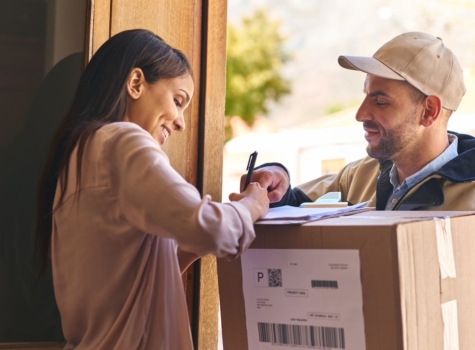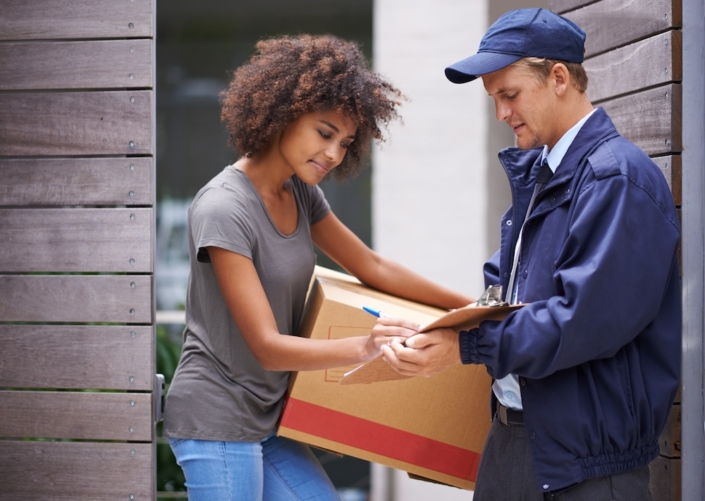Thanks to advanced technology and supply chain networks, physical goods can travel between states—and even countries—very quickly.
But despite all our logistics innovations, parcel shipping comes with unique challenges—and the last leg of a package’s journey is especially prone to inefficiencies.
What is last-mile delivery? What challenges does it pose for businesses? How can you build a last-mile strategy that keeps customers satisfied? In this article, we’ll answer these questions and more, diving into the complex logistics of last-mile deliveries.
What is last-mile delivery?
First things first: what does last-mile delivery mean? Last-mile delivery is sometimes known as final-mile delivery, and it refers to the process of moving a package from a transportation hub to its final destination—usually a consumer’s home. In other words, it’s the last stage of a package’s journey.
An optimized last-mile shipping strategy speeds up deliveries, saves money, decreases your carbon footprint, and improves overall logistics efficiency.
Unfortunately, this stage of fulfillment is the most costly part of the delivery process.
How much does last-mile delivery cost?
Last-mile delivery can make up 53% of total shipping costs (up from 41% in 2018). On a per-package basis, experts estimate that the last mile costs anywhere between $10 and $50, depending on a package’s size and the area where it’s being delivered.
Why is last-mile delivery so expensive? It’s largely due to the complexity of navigating urban environments, managing individual addresses, and considering specific delivery time windows. Personalized services like real-time tracking and proof of delivery further contribute to higher costs.
Who provides last-mile delivery services?
While national, regional, and local carriers most commonly provide last-mile delivery services, some businesses use alternative solutions (such as crowdsourcing) or handle last-mile delivery themselves.
- National parcel carriers. These organizations specialize in the shipment and transportation of packages, providing reliable delivery solutions through their established networks. Some of the most well-known carriers include USPS, UPS, and FedEx.
- Regional and local parcel carriers. Regional and local carriers offer shipping services within specific geographic areas. While they’re limited in scope, these smaller carriers often offer affordable rates.
- Crowdsourcing delivery platforms. Crowdsourcing platforms leverage mobile apps to connect businesses with drivers for on-demand transportation services, often extending their services to include last-mile delivery.
- Retailers and brands. To retain full control over the last-mile delivery experience, some businesses keep everything in-house, operating their own fleet of vehicles.
Now that you know your options for handling last-mile delivery, let’s review how it works (when you use traditional parcel carriers).
How last-mile delivery works
The last-mile delivery process is pretty straightforward, at least on paper. We’ll run through each step.
Step 1: Tracking numbers are created
Before the last-mile delivery process even begins, customers place orders through your ecommerce platform, and the data syncs with your order management system (OMS).
When you create shipping labels, each package is assigned a tracking number. While offering tracking isn’t mandatory, 64% of customers expect to be able to track every shipment they receive.
Step 2: Carriers transport packages between facilities
Once your packages are labeled and ready to go, carriers pick them up. From there, the packages are transported between carrier facilities—distribution centers (DCs) where shipments are scanned, sorted, and sent onward.
Packages may pass through several facilities, but once a package reaches its final distribution center, it officially marks the beginning of the last-mile segment of the journey.
Step 3: Packages are assigned to delivery drivers
Using technology to determine the most efficient delivery routes, carriers assign packages to drivers.
Step 4: Packages are scanned and loaded
Throughout the delivery process, customers have used tracking numbers to follow their packages’ progress. Right before packages are loaded onto delivery trucks or vans for last-mile delivery, they’re scanned so customers (and your business) know the order is out for delivery.
Then, delivery drivers follow their planned routes, dropping packages off to customers.
Step 5: Shipments reach recipients with proof of delivery
Finally, shipments arrive at the recipients’ homes, and the carrier provides proof of delivery.
With that, the last-mile delivery process has ended—unless the customer needs to return their item. If they need to ship something back to your business, the last-mile process happens in reverse.
Why mastering last-mile delivery matters
When you master last-mile delivery, you’ll speed up the overall shipping process, make more sales, and retain customers.
- Faster delivery. As mentioned earlier, last-mile logistics tends to be the least efficient part of the shipping process. But when you optimize the last mile, you increase delivery speed and accuracy. In a world where customers generally want 2-day shipping, shortening delivery times can make a big impact on your business.
- Increased customer satisfaction. A great last-mile delivery experience—one free from delays and errors—gives customer satisfaction a major boost.
- Increased sales. Satisfied customers are more likely to become repeat buyers and brand advocates. With high customer retention and acquisition, your sales will ultimately increase.
The benefits of a solid last-mile strategy are undeniable—but before you can access them, you’ll need to overcome the last-mile problem.
The last-mile problem: Common issues with last-mile delivery
Because last-mile delivery is complex and inefficient, it contributes significantly to the overall cost of delivery. This is known as the last-mile problem.
Common issues with last-mile delivery include:
- Slow travel speeds. During last-mile delivery, drivers constantly stop and start their vehicles, and this slow process is made worse by area-specific issues. In cities, congested traffic leads to slower delivery times, while in rural areas, vehicles have to travel long distances.
- Late or failed deliveries. If the aforementioned slow travel speeds cause delivery delays, customers won’t be happy. But failed deliveries can be even worse. In addition to wasting time, they also end up costing more—and that impacts your bottom line.
- Damaged packages. When goods are stored and delivered individually in parcels (rather than palletized), they’re more liable to damage.
- Environmental factors. Delivery vehicles produce lots of carbon emissions, especially in urban areas when traffic is backed up. As businesses and consumers become more aware of sustainability, it’s essential to be aware of your environmental impact and do what you can to lessen it.
- Visibility. Lack of real-time shipping visibility is one of the top last-mile challenges for businesses.
These obstacles may seem insurmountable, but you can take action to overcome them—read on to learn how.
How to cut time and labor costs during last-mile delivery
While some elements of last-mile delivery will be the carrier’s responsibility, your business should optimize where possible. The following suggestions will help you build a great last-mile delivery strategy.
Diversify your carrier mix
While carriers are generally reliable, they sometimes face issues. And when location-specific weather delays, employee strikes, or labor shortages occur, even the fastest carriers slow down. To make sure your shipments never do, partner with multiple carriers (over 80% of retailers work with at least five).
With so many logistics partners, shipping visibility can be an issue. So don’t just send shipments off with carriers and forget about them. Instead, continuously assess carrier performance. For each carrier, ask questions like, do they meet specific delivery requirements? Does their speed and accuracy vary by region? What customer feedback have you received about deliveries?
By diversifying your carrier mix, monitoring carrier performance, and proactively addressing issues, you’ll keep your last-mile shipping running smoothly even in the face of unforeseen circumstances.
Use shipping software to automate manual processes
Although full automation may still be in the future for your organization, you can strategically automate essential parts of the shipping process. The key? Shipping software.
With shipping software like EasyPost, you can automatically integrate with dozens of carriers, accessing heavily discounted rates. These technologies also allow you to automate label generation, package tracking, and more, cutting labor costs and minimizing errors caused by manual data input.
Provide package tracking
Package tracking is a crucial component of your last-mile delivery strategy. It provides real-time visibility into the location and status of a package throughout the delivery process, reducing customer anxiety and enhancing the overall customer experience.
Tracking doesn’t just boost customer satisfaction—it also helps your business in more tangible ways. The tracking data you pull in provides operational insights, allowing you to identify potential bottlenecks and address any issues that may arise during transit. A data-driven approach helps streamline logistics operations and ultimately improve the efficiency of the last-mile delivery process.
Offer a buy online, pick up in-store (BOPIS) option
Consumers are huge fans of buy online, pick up in-store (BOPIS). By avoiding the need for last-mile delivery entirely, BOPIS makes the shopping experience more convenient for customers. In addition to saving money on shipping costs, they can also avoid the stress of wondering when their package will arrive (and potentially waiting for it if it gets delayed).
BOPIS doesn’t just minimize last-mile hassles—it can also boost revenue. Customers who come to the store to pick up an online order are likely to browse and buy something else.
Top last-mile delivery carriers
Wondering who to partner with for last-mile shipping? You can never go wrong with major carriers such as USPS, UPS, and FedEx. Over the years, these shipping giants have proven that they can handle high volumes, and they offer many value-added services.
But national carriers aren’t your only options—local and regional carriers offer fast, affordable delivery to specific areas, often at a lower price point.
Some of our favorite regional carriers include:
- OnTrac
- Better Trucks
- GLS
- Spee-Dee Delivery
- CDL
- United Delivery Service
- Lone Star Overnight
- LaserShip
- Courier Express
Last-mile trends to watch out for
What does the future of last-mile delivery look like? As customers demand faster delivery, businesses will leverage AI and other technologies to improve processes and minimize friction.
- Rapid order fulfillment. For today’s consumers, same-day or next-day delivery options are a must. Businesses that invest in last-mile efficiency will see greater customer loyalty and stay competitive in the market.
- Artificial intelligence (AI). AI-powered shipping tools enhance decision-making, helping businesses adapt to changing market conditions and global supply chain disruptions while keeping shipping costs down.
- Drones and robots. Drone deliveries are on the horizon! By leveraging unmanned aerial vehicles (UAVs) and autonomous ground robots, shippers will be able to overcome challenges associated with traffic congestion, thereby reducing delivery times and cutting operational costs.
Make your last-mile delivery strategy easy
While the last mile problem may seem daunting, it doesn’t need to stand in the way of your business’s success. As you explore solutions to the many concerns you face—speed, cost, sustainability, and more—remember that you have many resources at your disposal, including shipping software to improve your logistics operations.
For example, with the EasyPost suite of shipping APIs, you can quickly integrate with carriers, find the best rates, automatically print shipping labels, track packages, and more. Last-mile delivery has never been easier.



